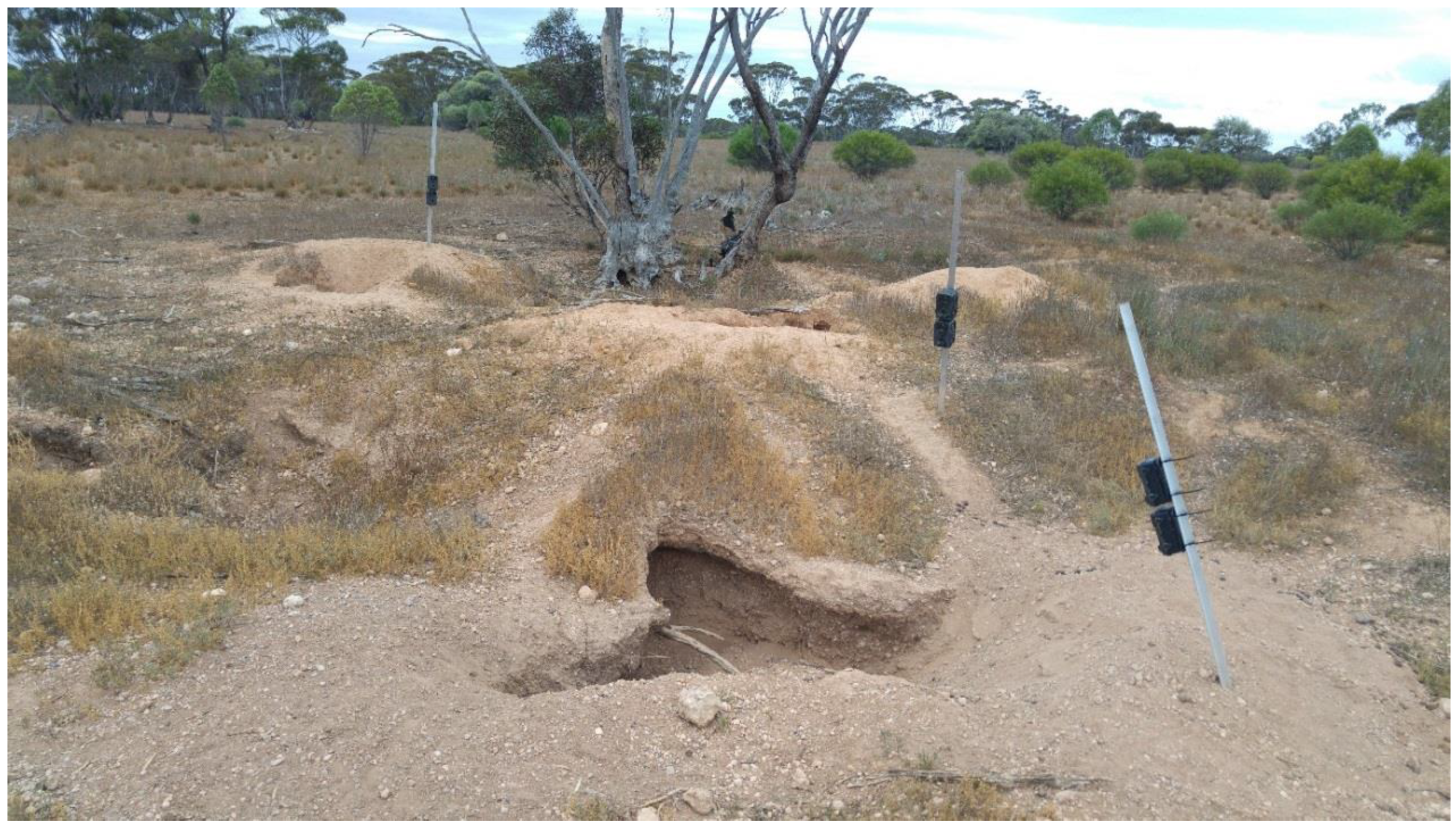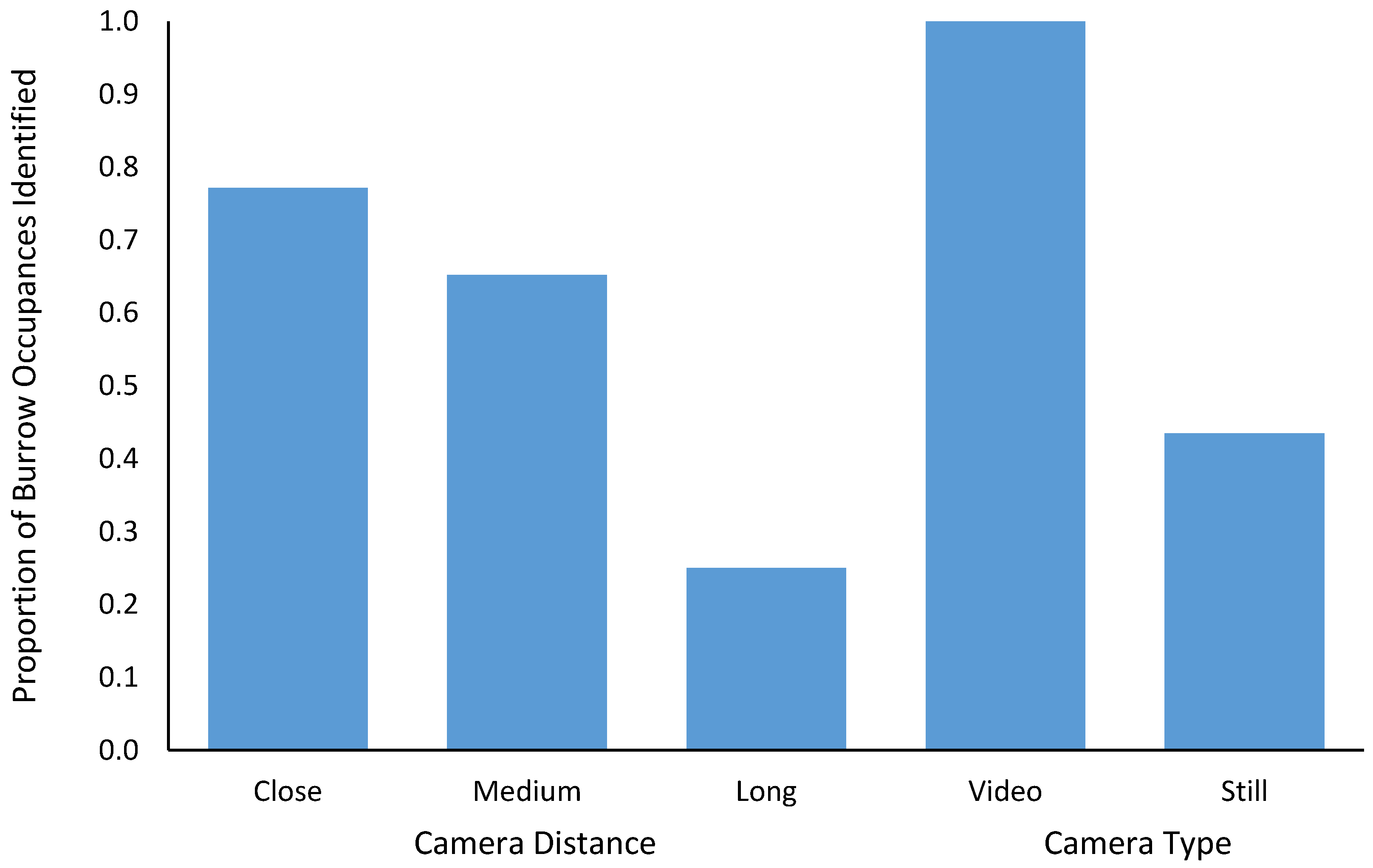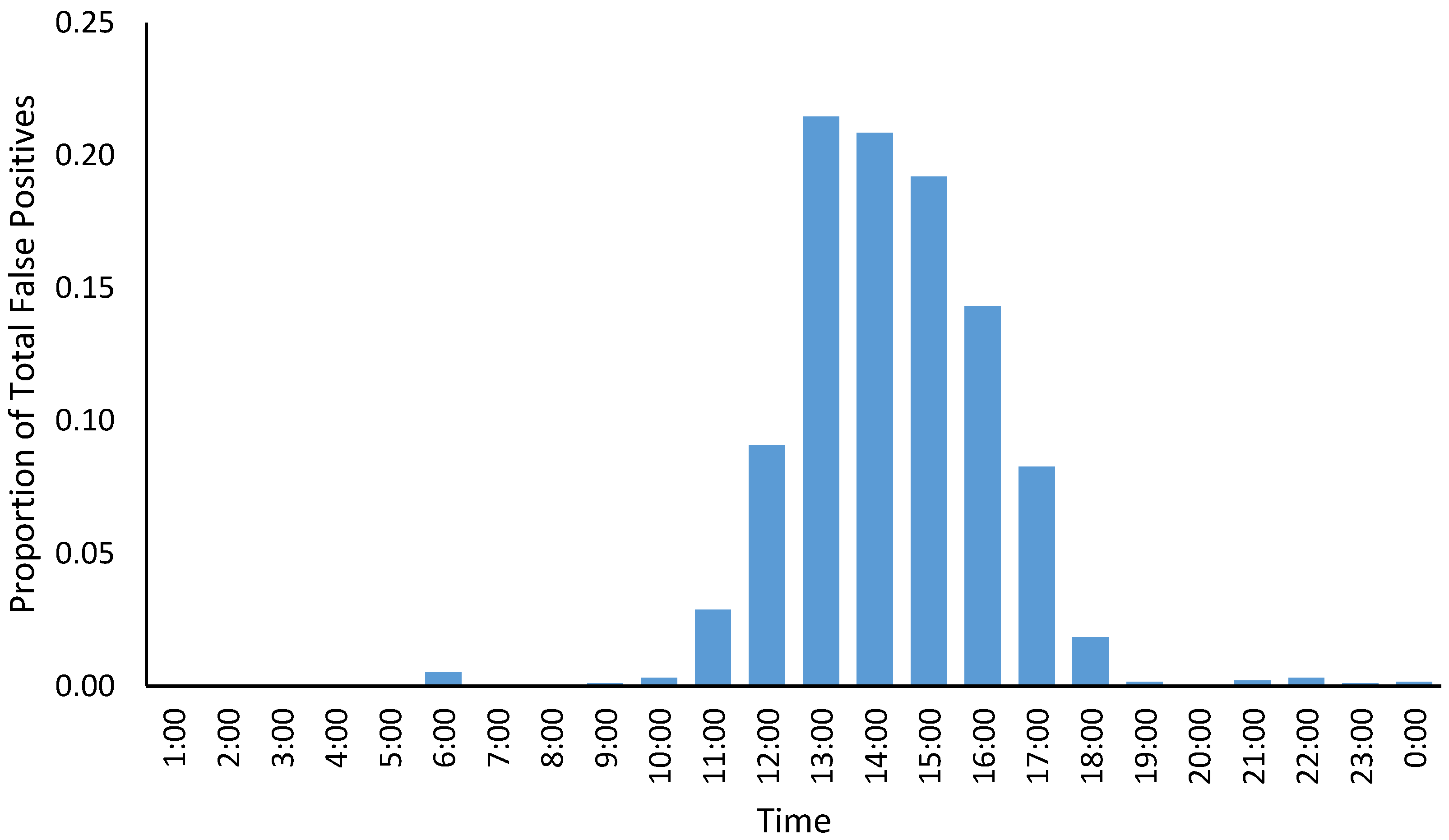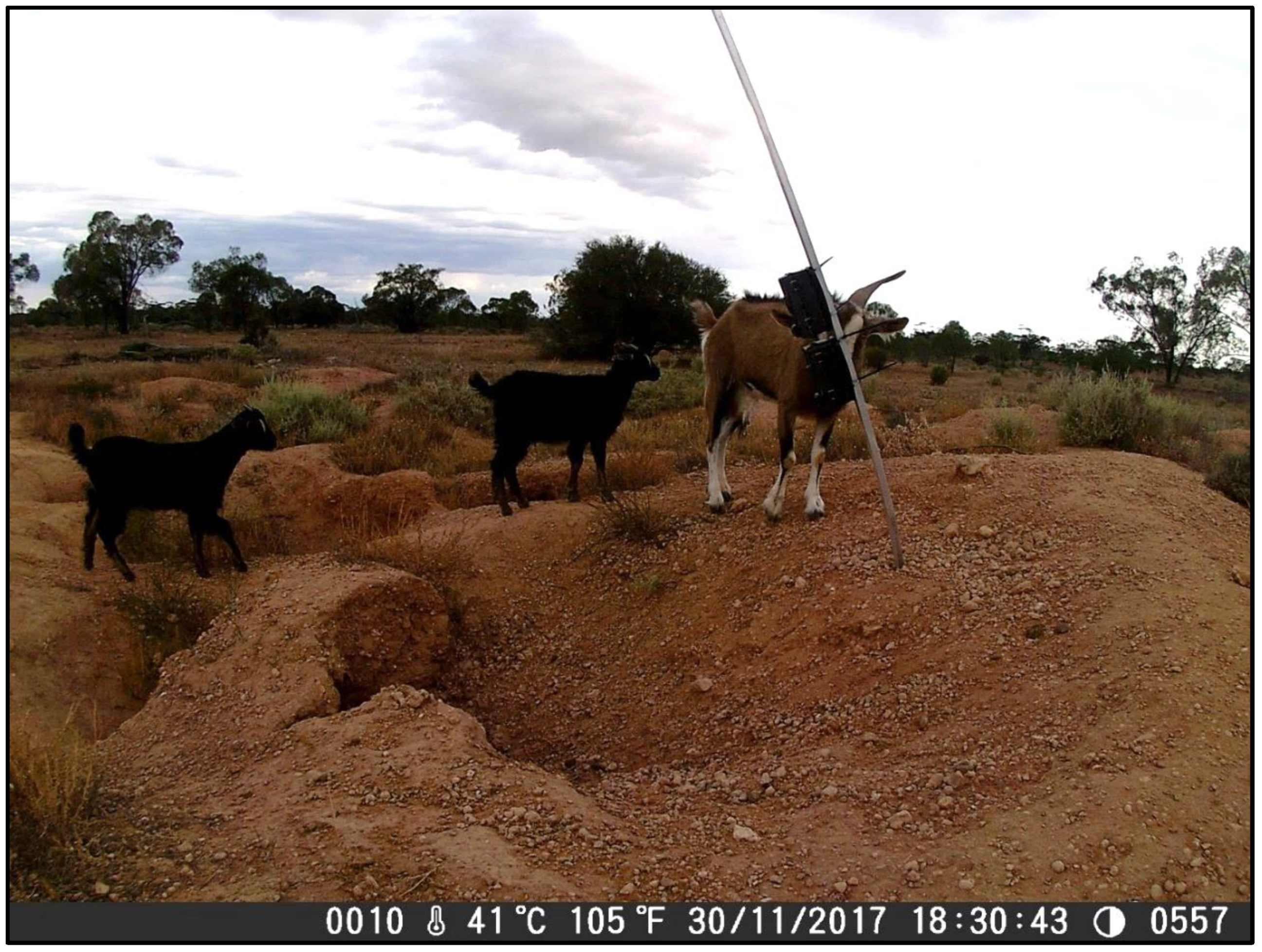A Comparison between Video and Still Imagery as a Methodology to Determine Southern Hairy-Nosed Wombat (Lasiorhinus latifrons) Burrow Occupancy Rates
Simple Summary
Abstract
1. Introduction
2. Materials and Methods
2.1. Phase 1: Murraylands Region
2.2. Data Analysis
2.3. Phase 2: Eyre Peninsula
3. Results
3.1. Phase 1
3.2. Phase 2
4. Discussion
5. Conclusions
Supplementary Materials
Author Contributions
Funding
Acknowledgements
Conflicts of Interest
Ethics Statement
References
- Swinbourne, M.J.; Taggart, D.A.; Swinbourne, A.M.; Lewis, M.; Ostendorf, B. Using satellite imagery to assess the distribution and abundance of southern hairy-nosed wombats (Lasiorhinus latifrons). Remote Sens. Environ. 2018, 211, 196–203. [Google Scholar] [CrossRef]
- McGregor, F.; Wells, R.T. Population status of the southern hairy-nosed wombat Lasiorhinus latifrons in the Murraylands of South Australia. In Wombats; Wells, R.T., Pridmore, P.A., Eds.; Surrey Beatty & Sons: Sydney, Australia, 1998; pp. 218–227. [Google Scholar]
- St John, B.J. Management of southern hairy-nosed wombats Lasiorhinus latifrons in South Australia. In Wombats; Wells, R.T., Pridmore, P.A., Eds.; Surrey Beatty & Sons: Sydney, Australia, 1998; pp. 228–242. [Google Scholar]
- Taggart, D.; Ostendorf, B. Southern Hairy-Nosed Wombats in the Murraylands. Report to the South Australian Murray Darling Basin Natural Resource Management Board; University of Adelaide and ZoosSA: Adelaide, Australia, 2012; pp. 74–85. [Google Scholar]
- Tiver, P.J. Distribution and Abundance of the Hairy-Nosed Wombat (Lasiorhinus latifrons) and Their Impact on the Rural Industry in the Fowler’s Bay Area; Department for the Environment: Adelaide, Australia, 1980. [Google Scholar]
- Tiver, P.J. Hairy-Nosed Wombats (Lasiorhinus latifrons) in the Murray Lands; National Parks and Wildlife Service of South Australia: Adelaide, Australia, 1981. [Google Scholar]
- Finlayson, G.; Shimmin, G.; Temple-Smith, P.; Handasyde, K.; Taggart, D. Burrow use and ranging behaviour of the southern hairy-nosed wombat (Lasiorhinus latifrons) in the Murraylands, South Australia. Aust. J. Zool. 2005, 265, 189–200. [Google Scholar] [CrossRef]
- Taggart, D.A.; Finlayson, G.R.; Richings, N.; Shimmin, G.; Dibben, R.; Adcock, J.; Temple-Smith, P.D. Environmental factors affecting the capture of southern hairy-nosed wombats (Lasiorhinus latifrons) by stunning. Wildl. Res. 2003, 30, 539–546. [Google Scholar] [CrossRef]
- McCallum, J. Changing use of camera traps in mammalian field research: Habitats, taxa and study types. Mammal. Rev 2013, 43, 196–206. [Google Scholar] [CrossRef]
- Meek, P.D.; Ballard, G.A.; Vernes, K.; Fleming, P.J. The history of wildlife camera trapping as a survey tool in Australia. Aust. Mammal. 2015, 37, 1–12. [Google Scholar] [CrossRef]
- Shannon, G.; Lewis, J.S.; Gerber, B.D. Recommended survey designs for occupancy modelling using motion-activated cameras: Insights from empirical wildlife data. PeerJ 2014, 2, e532. [Google Scholar] [CrossRef] [PubMed]
- Walter, W.D. Unusual documentation of elk behaviors using automated cameras. Proc. Okla Acad. Sci. 2015, 85, 81–83. [Google Scholar]
- Taylor, G.K. A long-term population study of the southern hairy-nosed wombat Lasiorhinus latifrons at Moorunde Wildlife Reserve, South Australia. In Wombats; Wells, R.T., Pridmore, P.A., Eds.; Surrey Beatty & Sons: Sydney, Australia, 1998; pp. 198–205. [Google Scholar]
- Finlayson, G.; White, C.; Dibben, R.; Shimmin, G.; Taggart, D. Activity patterns of the southern hairy-nosed wombat (Lasiorhinus latifrons) (Marsupialia: Vombatidae) in the South Australian Murraylands. Aust. Mammal. 2010, 32, 39–46. [Google Scholar] [CrossRef]
- Meek, P.D.; Ballard, G.A.; Fleming, P.J.S. The pitfalls of wildlife camera trapping as a survey tool in Australia. Aust. Mammal. 2015, 37. [Google Scholar] [CrossRef]
- Welbourne, D.J.; Claridge, A.W.; Paull, D.J.; Lambert, A.; Rowcliffe, M.; Disney, M. How do passive infrared triggered camera traps operate and why does it matter? Breaking down common misconceptions. Remote Sens. Ecol. Conserv. 2016, 2, 77–83. [Google Scholar] [CrossRef]
- Newey, S.; Davidson, P.; Nazir, S.; Fairhurst, G.; Verdicchio, F.; Irvine, R.J.; van der Wal, R. Limitations of recreational camera traps for wildlife management and conservation research: A practitioner’s perspective. Ambio 2015, 44, 624–635. [Google Scholar] [CrossRef] [PubMed]
- Porter-Dabrowski, G.; Taggart, D.; Ostendorf, B. Wombats from Space: A Multi-Scale and Multi-Method Approach to Assessing Southern Hairy-Nosed Wombat Population and Abundance in the Murraylands, South Australia; University of Adelaide: Adelaide, Australia, 2017. [Google Scholar]
- St John, B.J.; Saunders, G.M. Plan of Management for the Hairy-Nosed Wombat (Lasiorhinus latifrons) in South Australia; Department of Environment and Planning: Adelaide, Australia, 1989. [Google Scholar]
- Swinbourne, M.J.; Taggart, D.A.; Ostendorf, B. The Use of Ground Penetrating Radar to Map the Warrens of Southern Hairy-Nosed Wombats (Lasiorhinus latifrons) in Different Soil Types; Bachelor of Science (Honours); University of Adelaide: Adelaide, Australia, 2015. [Google Scholar]
- Marshall, V.M.; Taggart, D.A.; Ostendorf, B. Scale-dependent habitat analysis and implications for climate change risk for the southern hairy-nosed wombat. Aust. Mammal. 2017, 40, 162–172. [Google Scholar] [CrossRef]
- Tartowski, S.; Stemann, J. Effect of discontinuing culling on the estimated number of southern hairy-nosed wombats. In Wombats; Wells, R.T., Pridmore, P.A., Eds.; Surrey Beatty & Sons: Sydney, Australia, 1998; pp. 206–217. [Google Scholar]
- Wells, R. Thermoregulation and activity rhythms in the hairy-nosed wombats, Lasiorhinus latifrons (Owen), (Vombatidae). Aust. J. Zool. 1978, 26, 639–651. [Google Scholar] [CrossRef]
- Stott, A.V. Problems with southern hairy-nosed wombats Lasiorhinus latifrons in the agricultural lands of the far west coast of South Australia. In Wombats; Wells, R.T., Pridmore, P.A., Eds.; Surrey Beatty & Sons: Sydney, Australia, 1998; pp. 280–286. [Google Scholar]
- Finlayson, G.; Shimmin, G.; Temple-Smith, P.; Handasyde, K.; Taggart, D. Monitoring the activity of a southern hairy-nosed wombat, Lasiorhinus latifrons, using temperature dataloggers. Aust. Mammal. 2003, 25, 205–208. [Google Scholar]
- Taggart, D.A.; Temple-Smith, P.D. Southern hairy-nosed wombat, Lasiorhinus latifrons. In The Mammals of Australia, 3rd ed.; Dyck, S.V., Strahan, R., Eds.; Reed New Holland: Sydney, Australia, 2008; pp. 204–206. [Google Scholar]
- Walker, F.M.; Taylor, A.C.; Sunnucks, P. Does soil type drive social organization in southern hairy-nosed wombats? Mol. Ecol. 2007, 16, 199–208. [Google Scholar] [CrossRef] [PubMed]
- Swinbourne, M.J.; Taggart, D.A.; Sparrow, E.; Hatch, M.; Ostendorf, B. Ground penetrating radar as a non-invasive tool to better understand the population dynamics of a fossorial species: Mapping the warrens of southern hairy-nosed wombats (Lasiorhinus latifrons). Wildl. Res. 2016, 42, 678–688. [Google Scholar] [CrossRef]
- Walker, F.M. Sociobiology Inferred from Relatedness Structure via Remotely-Collected DNA in Southern Hairy-Nosed Wombats, Lasiorhinus latifrons; Monash University: Melbourne, Australia, 2004. [Google Scholar]
- Walker, F.M.; Sunnucks, P.; Taylor, A.C. Genotyping of “captured” hairs reveals burrow-use and ranging behavior of southern hairy-nosed wombats. J. Mammal. 2006, 87, 690–699. [Google Scholar] [CrossRef]







| Site # | 1 | 2 | 3 | 4 | 5 | 6 | 7 | 8 | 9 | 10 | |
|---|---|---|---|---|---|---|---|---|---|---|---|
| Moorunde | Warren Diameter (m) | 10 | 13 | 11 | 15 | 12 | |||||
| No. of Active Burrows | 1 | 2 | 3 | 4 | 5 | ||||||
| No. of Burrows | 3 | 5 | 6 | 8 | 6 | ||||||
| Brookfield | Warren Diameter (m) | 22 1 | 22 1 | 22 1 | 17 2 | 17 2 | |||||
| No. of Active Burrows | 4 | 4 | 4 | 3 | 3 | ||||||
| No. of Burrows | 12 | 12 | 12 | 10 | 10 | ||||||
| Dakalanta | Warren Diameter (m) | 11 | 13 | 6 | 16 | 12 | 9 | 14 | 19 | 5 | 7 |
| No. of Active Burrows | 2 | 2 | 1 | 5 | 2 | 2 | 3 | 4 | 1 | 1 | |
| No. of Burrows | 4 | 3 | 1 | 6 | 5 | 3 | 8 | 6 | 1 | 1 | |
| Site # | 1 | 2 | 3 | 4 | 5 | 6 | 7 | 8 | 9 | 10 | Mean | |
|---|---|---|---|---|---|---|---|---|---|---|---|---|
| Moorunde | Burrow Occupied | 0.00 | 0.56 | 0.12 | 0.60 | 0.88 | 0.43 | |||||
| Wombat Occupancy | 0.00 | 0.56 | 0.12 | 0.68 | 1.00 | 0.47 | ||||||
| Brookfield | Burrow Occupied | 0.40 | 0.24 | 0.32 | 0.56 | - | 0.38 | |||||
| Wombat Occupancy | 0.40 | 0.24 | 0.32 | 0.56 | - | 0.38 | ||||||
| Dakalanta | Burrow Occupied | 0.00 | 1.00 | 0.76 | - | 0.08 | 0.40 | 0.08 | 0.40 | 0.28 | 0.25 | 0.35 |
| Wombat Occupancy | 0.00 | 1.72 | 0.88 | - | 0.08 | 0.40 | 0.08 | 0.40 | 0.28 | 0.25 | 0.42 | |
© 2018 by the authors. Licensee MDPI, Basel, Switzerland. This article is an open access article distributed under the terms and conditions of the Creative Commons Attribution (CC BY) license (http://creativecommons.org/licenses/by/4.0/).
Share and Cite
Swinbourne, M.J.; Taggart, D.A.; Ostendorf, B. A Comparison between Video and Still Imagery as a Methodology to Determine Southern Hairy-Nosed Wombat (Lasiorhinus latifrons) Burrow Occupancy Rates. Animals 2018, 8, 186. https://doi.org/10.3390/ani8110186
Swinbourne MJ, Taggart DA, Ostendorf B. A Comparison between Video and Still Imagery as a Methodology to Determine Southern Hairy-Nosed Wombat (Lasiorhinus latifrons) Burrow Occupancy Rates. Animals. 2018; 8(11):186. https://doi.org/10.3390/ani8110186
Chicago/Turabian StyleSwinbourne, Michael J., David A. Taggart, and Bertram Ostendorf. 2018. "A Comparison between Video and Still Imagery as a Methodology to Determine Southern Hairy-Nosed Wombat (Lasiorhinus latifrons) Burrow Occupancy Rates" Animals 8, no. 11: 186. https://doi.org/10.3390/ani8110186
APA StyleSwinbourne, M. J., Taggart, D. A., & Ostendorf, B. (2018). A Comparison between Video and Still Imagery as a Methodology to Determine Southern Hairy-Nosed Wombat (Lasiorhinus latifrons) Burrow Occupancy Rates. Animals, 8(11), 186. https://doi.org/10.3390/ani8110186






